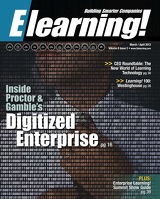Elearning! Magazine: Building Smarter Companies via Learning & Workplace Technologies.
Page 10 of 52
News Will Top Workers Leave in 2012?
Predicting and Justifying Corporate E-learning
While companies paid 14 percent more ($171.5 billion) on learning and development in 2010, adoption did not improve. Learning in corporate America needs to be better predicted and justified, says Dave Basarab, an expert trainer, evaluator and author. He also says that many companies have a gap between the high amount they're spending on training but have low adoption rates.
Basarab believes that:
>> Despite economic challenges, senior executives know that L&D; is critical to drive growth and sustain a competitive advantage.
>> By becoming more effective in predicting learning's out- comes, companies will elevate their learning programs to the next level.
Forty-three percent of hiring managers and human resource man- agers are concerned top workers will leave their organizations in 2012, according to a new survey. The concern could be attributa- ble to an increase in voluntary turnover: workers leaving organiza- tions for other opportunities. A third (34 percent) of human resource managers see an increase in voluntary turnover in 2011. Hiring managers in industries that rely on high-skilled workers
are most concerned about a potential talent exodus from jobs in information technology (54 percent). >>Top staffing challenges in 2012:
>> Being able to retain top talent: 35 percent
>> Being able to provide competitive compensation: 35 percent >> Worker burnout: 32 percent
>> Maintaining productivity levels: 29 percent >> Being able to provide upward mobility: 26 percent >> Can't find high-skilled applicants: 24 percent
Don't have the budget to recruit: 13 percent —Source: CareerBuilder
What Next for QR?
Half of smartphone users have now scanned a QR (mobile bar- code) code at least once. As QR codes pop up in more places, awareness of them is grow- ing, and many users seem to learn what they do before learning what they are called. While just 21 percent of Internet users have heard of QR codes before, more than four in five know one when they see one. QR codes are becoming hard to miss, even for those without a smartphone. Data indicates that well over 90 per- cent of the top 100 magazines in the U.S. have featured at least one mobile barcode since last May; as recently as November, 2010, just 9 percent had.
Besides magazines, other important uses of QR codes appear on in-store signage and packaging and business cards. Why do smartphone users can QR codes? Forty-six do it out of simple curiosi- ty; 41 percent do it with a hope of obtaining
more information. —Sources: eMarketer, Chadwick Martin Bailey,
Nellymoser 10 March / April 2012 Elearning!
>> Having the right learning strategy in place will increase an organization's ability to create value.
>> Organizations need to predict training's results, value, intention, adoption and impact to make smarter, more strategic training and evaluation investments.
>> While prediction is crucial, so is adoption. Learning is con- tinuous and shouldn't stop when a training session ends; information must "stick" to be used effectively in the work- place.
—More info: www.davebasarab.com
